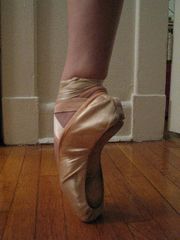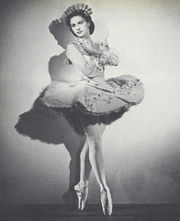En pointe

En pointe (pointe) means "on the tips of the toes" and is a part of classical ballet technique made possible by specially reinforced shoes called pointe shoes or toe shoes. The technique developed from the desire for dancers to appear weightless and sylph-like and has evolved to enable dancers to dance on the tips of their toes for extended periods of time. Although both men and women are capable of dancing en pointe, it is more commonly done by women.
It takes considerable strength in the feet, ankle, leg, knee, and abdomen to dance en pointe. Students must be at least 11 or 12 years of age before attempting pointe work because bones and growth plates in the feet are usually not fully hardened and developed prior to this age. Serious foot deformities can result from starting pointe too early even if the student is otherwise strong and skillful. Attempting to dance en pointe before the feet and toes are fully grown can cause career-ending damage that will prevent dancing en pointe for a lifetime.

For a history of pointe work, see
Contents |
Preparing for pointe
Because serious foot deformities can result from starting pointe too early, students usually begin dancing en pointe after the age of 11. In the major dance academies, which have physicians available to ensure that the dancers' feet have ossified sufficiently, students may be allowed to start pointe work earlier.[1][2] It is dangerous to start en pointe at such a young age without orthopaedic approval because the bones in the feet are still growing and can be permanently damaged.
Otherwise, students are ready for pointe when they can hold their turnout from the hips while performing center combinations, hold a proper ballet position (straight back, good turnout, etc.), pull up correctly in the legs, and balance securely in releve because dancing en pointe requires one to use the entire body, including the legs, back, and abdominal muscles.[3]
Pedicures are not advised for pointe dancers and dead skin and calluses on the feet are helpful and act as insulation against the strain of the shoe. Blisters, boils, athlete's foot, cuts of the feet, and even bleeding are to be expected. Toenails are generally cut at least one day before dance class or concerts to let the toes adjust to the new length of the nails.
Preparation for pointe work is a gradual process, starting with strengthening exercises at the barre. This will vary according to the teacher's preferences and syllabus. The first exercises at the barre are usually relevés and échappés.[4] Only once the student is fully comfortable in executing the steps on both feet (and the tendons are strong enough), steps ending on one foot are introduced, such as pas de bourrée en pointes and retiré en pointes.
After barre work, the student will progress to exercises in the center. This will usually be led by an instructor who will be stressing proper turnout, pointing of the toes when raised, and proper use of ballet technique while en pointe. In centre practice, Mme Vaganova[5] suggests as first exercises on both feet relevés and échappés en pointe.
Preparing the Shoes
The stiffened shank and box help spread the weight of the dancer's body across the foot instead of being concentrated in the toes. For this to be successful, the shoe must be fitted perfectly to suit the dancer's foot. Each pointe shoe manufacturer makes a range of shoes to fit different foot shapes, e.g., high or low arch, high or low profile, Egyptian, Greek or Giselle toes, etc.
Pointe shoe fitters require extensive training and experience to identify the different foot conformations and the makes and models of shoes that suit them. For this reason, it is recommended that students do not attempt to buy their first pointe shoes online or by mail but visit a specialist ballet store for expert advice.
Pointe shoes must be "broken in" before dancing in them. This consists of bending the hard shank sufficiently to create a platform for the heel and sometimes softening the box slightly to allow the shoe to easily bend in demi-pointe.
The box and shank of pointe shoes become less supportive with use. Their life can be extended with the use of cyanoacrylate glue, which stiffens those areas and makes them last a little longer.
Pointe technique
Dancer may rise on the toes by passing through half-pointe or demi-pointe, or by springing on to her toes with a small hop. The second method is more common in the Russian method[6] and was first introduced by Enrico Cecchetti.[7]
Modern ballet technique demands the use of both- usually rolling through for adages and springing on pointe in allegros.
Common injuries
Dancing en pointe places stress on the dancer's feet. Common injuries related to dancing en pointe are:
- Blisters
- Blisters are caused by repeated rubbing of skin against the rough, hardened inside on the shoe's box, especially if the shoes are poorly fitted. Blisters can be prevented or lessened by wrapping the toes with medical tape or by using padding.
- Bunions
- a joint deformity usually in the big toe caused by cramping of the toes within the shoe's box or by poorly fitted shoes. Dancers can prevent bunions by putting a spacer between the big toe and the next toe.
- Bunionette
- a joint deformity usually in the dancer's little toe.
- Bursitis
- Bursitis is the inflammation of one or more bursae (small sacs) of synovial fluid in the body. The bursae rest at the points where internal functionaries, such as muscles and tendons, slide across bone. Healthy bursae create a smooth, almost frictionless functional gliding surface, making normal movement painless. When bursitis occurs, however, movement relying upon the inflamed bursa becomes difficult and painful. Moreover, movement of tendons and muscles over the inflamed bursa aggravates its inflammation, perpetuating the problem.
- Bruises
- bruising is common on the tip of the toe, especially if no padding is used.
- Bruised toenails
- caused by heavy pressure on the front of the nail when the nail is not cut short. This can be very painful and may cause the dancer to burn a hole in the nail to relieve some of the pressure.
- Calluses
- Calluses are thickened areas of skin which form on the bottom and sides of the feet. While a small amount may be helpful, too much callusing can indicate poor posture or poorly fitted shoes. Especially thick callus may crack or bleed and can be painful, causing a burning sensation. Calluses can be kept under control by soaking the feet in warm water and mild soap for 10 – 15 minutes. Excess callus can then be filed off gently, not removing the whole.
- Contusion
- A bruise, also called a contusion
- Corns
- Corns result from incorrectly fitted shoes and form in places that do not bear weight.
- Cuts between the toes
- Cuts can occur between toes as a result of the pressure of a dancer's toenails digging into the toes next to them. However, with proper trimming, filing and fitting, this can usually be prevented.
- Dancer's heel (Plantar fasciitis)
- When the tendon on the instep of the foot tightens, causing the instep and heel to hurt very badly.
- dorsal exostosis
- Extensor tendinitis
- Hallux limitus and rigidus
- Hammer toes
- when the toes bend up permanently at the middle joint.
- Ingrown toenails
- Jammed big toes
- Neuromas
- Sesamoiditis
- Sprained ankles
- Stress fractures
- Thickened toenails
Injury prevention
Because pointe work can cause friction between the toes and the hard box of the pointe shoe, dancers use several methods to prevent chafing and blisters. Dancers often use lamb's wool or toe pads made of foam or gel, or even folded paper toweling. If any type of padding is used excessively, it will impair the ability to "feel the floor." Many dancers also use sports tape around their toes in order to further prevent blisters and bruised toenails. Also, keeping the toenails clipped as short as possible (without bleeding) is useful in preventing bruised toenails.
References
- ↑ Scuola di Ballo del Teatro alla Scala: Testo programmatico per lo studio della danza classica - Teatro alla Scala, A. M. Prina
- ↑ Royal Swedish Ballet School as reported in "The pointe book"
- ↑ Fit feet - ballet dancers and pointe work Dance Magazine Sept 1997 Marian Horosko
- ↑ Testo programmatico per lo studio della danza classica - Teatro alla Scala, A. M. Prina
- ↑ Vaganova, A. Basic principles of classical ballet
- ↑ Vaganova, A. Basic principles of classical ballet
- ↑ Theory and Practice of Classical Theatrical Dancing, C. Beaumont, S. Idzikowski
External links
|
|||||||||||||||||||||||||
